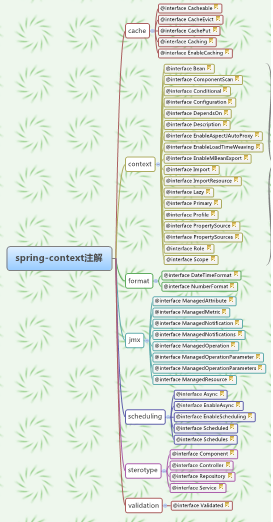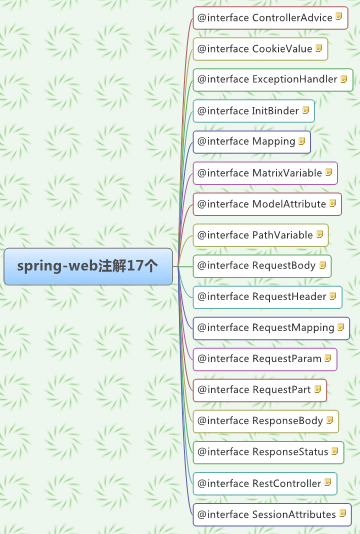Spring4.X注解概述
1. 背景
注解可以减少代码的开发量,spring提供了丰富的注解功能,因项目中用到不少注解,因此下定决心,经spring4.x中涉及到的注解罗列出来,供查询使用。
2. spring注解图
2.1 spring-context模块的注解图

2.2 spring-web注解

2.3 spring其它模块的注解

3. 注解实例说明
本来准备写一些demo来介绍常用的注解用法,但网上搜索了一些,发现有类似的了,就直接整理后引用了。
4 附录:(为了让读者不用翻页,我直接copy过来了,并进行了适当的排版,若涉及到版权问题,请告知,我将删除之)
Spring2.5 注解介绍(3.0通用)
Auther: 韩群峰 Version: 1.0.0 Date: 2011-03-15
注解说明
• 注册注解处理器
• 方式一:bean
<bean class="org.springframework.beans.factory.annotation.
AutowiredAnnotationBeanPostProcessor"/>
• 方式二: 命名空间<context:annotation-config />
<context:annotationconfig /> 将隐式地向Spring 容器注册AutowiredAnnotationBeanPostProcessor、CommonAnnotationBeanPostProcessor 、 PersistenceAnnotationBeanPostProcessor 以及RequiredAnnotationBeanPostProcessor 这4 个BeanPostProcessor 。
• 方式三: 命名空间<context:component-scan />
如果要使注解工作,则必须配置component-scan ,实际上不需要再配置annotation-config。
base-package 属性指定了需要扫描的类包,类包及其递归子包中所有的类都会被处理。还允许定义过滤器将基包下的某些类纳入或排除。
• Spring 支持以下4 种类型的过滤方式:
• 注解 org.example.SomeAnnotation 将所有使用SomeAnnotation 注解的类过滤出来
• 类名指定 org.example.SomeClass 过滤指定的类
• 正则表达式 com.kedacom.spring.annotation.web..* 通过正则表达式过滤一些类
• AspectJ 表达式 org.example..*Service+ 通过AspectJ 表达式过滤一些类
• 正则表达式的过滤方式举例:
<context:component-scanbase-package="com.casheen.spring.annotation">
<context:exclude-filtertype="regex"
expression="com.casheen.spring.annotation.web..*"/>
</context:component-scan>
• 注解的过滤方式举例:
<context:component-scan base-package="com.netqin" >
<context:include-filter type="annotation"
expression="org.springframework.stereotype.Controller"/>
<context:include-filter type="annotation"
expression="org.springframework.stereotype.Service"/>
<context:include-filter type="annotation"
expression="org.springframework.stereotype.Repository"/>
</context:component-scan>
启用Spring MVC 注解
• 启动Spring MVC 的注解功能,完成请求和注解POJO 的映射
• <bean class="org.springframework.web.servlet.mvc.annotation.AnnotationMethodHandlerAdapter"/>
注解举例:
@Controller
• 例如
@Controller
public class SoftCreateController extends SimpleBaseController {}
• 或者
@Controller("softCreateController")
• 说明
@Controller 负责注册一个bean 到spring 上下文中,bean 的ID 默认为类名称开头字母小写
@Service
• 例如
@Service
public class SoftCreateServiceImpl implements ISoftCreateService {}
• 或者
@Service("softCreateServiceImpl")
• 说明
@Service 负责注册一个bean 到spring 上下文中,bean 的ID 默认为类名称开头字母小写
@Autowired
• 例如
@Autowired
private ISoftPMService softPMService;
• 或者
@Autowired(required=false)
private ISoftPMService softPMService = new SoftPMServiceImpl();
• 说明
@Autowired 根据bean 类型从spring 上线文中进行查找,注册类型必须唯一,否则报异常。与@Resource 的区别在于,@Resource 允许通过bean 名称或bean 类型两种方式进行查找@Autowired(required=false) 表示,如果spring 上下文中没有找到该类型的bean 时, 才会使用new SoftPMServiceImpl();
@Autowired 标注作用于 Map 类型时,如果 Map 的 key 为 String 类型,则 Spring 会将容器中所有类型符合 Map 的 value 对应的类型的 Bean 增加进来,用 Bean 的 id 或 name 作为 Map 的 key。
@Autowired 还有一个作用就是,如果将其标注在 BeanFactory 类型、ApplicationContext 类型、ResourceLoader 类型、ApplicationEventPublisher 类型、MessageSource 类型上,那么 Spring 会自动注入这些实现类的实例,不需要额外的操作。
@RequestMapping
• 类
@Controller
@RequestMapping("/bbtForum.do")
public class BbtForumController {
@RequestMapping(params = "method=listBoardTopic")
public String listBoardTopic(int topicId,User user) {}
}
• 方法
@RequestMapping("/softpg/downSoftPg.do")
@RequestMapping(value="/softpg/ajaxLoadSoftId.do",method = POST)
@RequestMapping(value = "/osu/product/detail.do", params = { "modify=false" }, method =POST)
• 说明
@RequestMapping 可以声明到类或方法上
• 参数绑定说明
如果我们使用以下的 URL 请求:
http://localhost/bbtForum.do?method=listBoardTopic&topicId=1&userId=10&userName=tom
topicId URL 参数将绑定到 topicId 入参上,而 userId 和 userName URL 参数将绑定到 user 对象的 userId 和 userName 属性中。和 URL 请求中不允许没有 topicId 参数不同,虽然 User 的 userId 属性的类型是基本数据类型,但如果 URL 中不存在 userId 参数,Spring 也不会报错,此时 user.userId 值为 0 。如果 User 对象拥有一 个 dept.deptId 的级联属性,那么它将和 dept.deptId URL 参数绑定。
@RequestParam
• 参数绑定说明
@RequestParam("id")
http://localhost/bbtForum.do?method=listBoardTopic&id=1&userId=10&userName=tom
listBoardTopic(@RequestParam("id")int topicId,User user) 中的 topicId 绑定到 id 这个 URL 参数, 那么可以通过对入参使用 @RequestParam 注解来达到目的
@RequestParam(required=false):参数不是必须的,默认为true
@RequestParam(value="id",required=false)
请求处理方法入参的可选类型
• Java 基本数据类型和 String
默认情况下将按名称匹配的方式绑定到 URL 参数上,可以通过 @RequestParam 注解改变默认的绑定规则
• request/response/session
既可以是 Servlet API 的也可以是 Portlet API 对应的对象,Spring 会将它们绑定到Servlet 和 Portlet 容器的相应对象上
• org.springframework.web.context.request.WebRequest
内部包含了 request 对象
• java.util.Locale
绑定到 request 对应的 Locale 对象上
• java.io.InputStream/java.io.Reader
可以借此访问 request 的内容
• java.io.OutputStream / java.io.Writer
可以借此操作 response 的内容
• 任何标注了 @RequestParam 注解的入参
被标注 @RequestParam 注解的入参将绑定到特定的 request 参数上。
• java.util.Map / org.springframework.ui.ModelMap
它绑定 Spring MVC 框架中每个请求所创建的潜在的模型对象,它们可以被 Web 视图对象访问(如 JSP )
• 命令/ 表单对象(注:一般称绑定使用 HTTP GET 发送的 URL 参数的对象为命令对象,而称绑定使用HTTP POST 发送的 URL 参数的对象为表单对象)
它们的属性将以名称匹配的规则绑定到 URL 参数上,同时完成类型的转换。
而类型转换的规则可以通过 @InitBinder 注解或通过 HandlerAdapter 的配置进行调 整
• org.springframework.validation.Errors / org.springframework.validation.BindingResult
为属性列表中的命令/ 表单对象的校验结果,注意检验结果参数必须紧跟在命令/ 表单对象的后面
• org.springframework.web.bind.support.SessionStatus
可以通过该类型 status 对象显式结束表单的处理,这相当于触发 session 清除其中的通过@SessionAttributes 定义的属性
请求处理方法返回值的可选类型
• void
此时逻辑视图名由请求处理方法对应的 URL 确定,如以下的方法:
@RequestMapping("/welcome.do")
public void welcomeHandler() {}
对应的逻辑视图名为 “ welcome ”
• String
此时逻辑视图名为返回的字符,如以下的方法:
@RequestMapping(method = RequestMethod.GET)
public String setupForm(@RequestParam("ownerId") int ownerId, ModelMap model) {
Owner owner = this.clinic.loadOwner(ownerId);
model.addAttribute(owner);
return "ownerForm";
}
对应的逻辑视图名为 “ ownerForm ”
• org.springframework.ui.ModelMap
和返回类型为 void 一样,逻辑视图名取决于对应请求的 URL ,如下面的例子:
@RequestMapping("/vets.do")
public ModelMap vetsHandler() {
return new ModelMap(this.clinic.getVets());
}
对应的逻辑视图名为 “ vets ” ,返回的 ModelMap 将被作为请求对应的模型对象,可以在 JSP 视图页面中访问到。
• ModelAndView
当然还可以是传统的 ModelAndView 。
@ModelAttribute
• 作用域:request
• 例如
@RequestMapping("/base/userManageCooper/init.do")
public String handleInit(@ModelAttribute("queryBean") ManagedUser sUser,Model model,){
• 或者
@ModelAttribute("coopMap")// 将coopMap 返回到页 面
public Map<Long,CooperatorInfo> coopMapItems(){}
• 说明
@ModelAttribute 声明在属性上,表示该属性的value 来源于model 里"queryBean" ,并被保存到model 里@ModelAttribute声明在方法上,表示该方法的返回值被保存到model 里
@Cacheable 和@CacheFlush
• @Cacheable :声明一个方法的返回值应该被缓存。例如:@Cacheable(modelId = "testCaching")
• @CacheFlush :声明一个方法是清空缓存的触发器。例如:@CacheFlush(modelId = "testCaching")
• 说明
要配合缓存处理器使用,参考: http://hanqunfeng.iteye.com/blog/603719
spring3.0没有对缓存提供支持,不过3.1之后就有了,可以参考:Spring3.1 Cache注解
@Resource
• 例如
@Resource
private DataSource dataSource; // inject the bean named 'dataSource'
• 或者
@Resource(name="dataSource")
@Resource(type=DataSource.class)
• 说明
@Resource 默认按bean 的name 进行查找,如果没有找到会按type 进行查找,
此时与@Autowired 类 似
在没有为 @Resource 注解显式指定 name 属性的前提下,如果将其标注在 BeanFactory 类型、ApplicationContext 类型、ResourceLoader 类型、 ApplicationEventPublisher 类型、MessageSource 类型上,那么 Spring 会自动注入这些实现类的实例,不需要额外的操作。此时 name 属性不需要指定 ( 或者指定为""),否则注入失败;
@PostConstruct 和@PreDestroy
• @PostConstruct
在方法上加上注解@PostConstruct ,这个方法就会在Bean 初始化之后被Spring 容器执 行
(注:Bean 初始化包括,实例化Bean ,并装配Bean 的属性(依赖注入))。
• @PreDestroy
在方法上加上注解@PreDestroy ,这个方法就会在Bean 被销毁前被Spring 容器执行。
@Repository
• 与@Controller 、@Service 类似,都是向spring 上下文中注册bean ,不在赘述。
@Component (不推荐使用)
• @Component
@Component 是所有受Spring 管理组件的通用形式,Spring 还提供了更加细化的注解形式: @Repository 、@Service、@Controller ,它们分别对应存储层Bean ,业务层Bean ,和展示层Bean 。
目前版本(2.5 )中,这些注解与@Component 的语义是一样的,完全通用, 在Spring 以后的版本中可能会给它们追加更多的语义。 所以,我们推荐使用@Repository 、@Service 、@Controller 来替代@Component 。
@Scope
• 例如
@Scope("session")
@Repository()
public class UserSessionBean implementsSerializable {}
• 说明
在使用XML 定义Bean 时,可以通过bean 的scope 属性来定义一个Bean 的作用范围,
同样可以通过@Scope 注解来完成
@Scope中可以指定如下值:
singleton:定义bean的范围为每个spring容器一个实例(默认值)
prototype:定义bean可以被多次实例化(使用一次就创建一次)
request:定义bean的范围是http请求(springMVC中有效)
session:定义bean的范围是http会话(springMVC中有效)
global-session:定义bean的范围是全局http会话(portlet中有效)
@SessionAttributes
• 说明
Spring 允许我们有选择地指定 ModelMap 中的哪些属性需要转存到 session 中,
以便下一个请求属对应的 ModelMap 的属性列表中还能访问到这些属性。
这一功能是通过类定义处标注 @SessionAttributes 注解来实现的。
@SessionAttributes 只能声明在类上,而不能声明在方法上。
• 例如
@SessionAttributes("currUser") // 将ModelMap 中属性名为currUser 的属性
@SessionAttributes({"attr1","attr2"})
@SessionAttributes(types = User.class)
@SessionAttributes(types = {User.class,Dept.class})
@SessionAttributes(types = {User.class,Dept.class},value={"attr1","attr2"})
@InitBinder
• 说明
如果希望某个属性编辑器仅作用于特定的 Controller ,
可以在 Controller 中定义一个标注 @InitBinder 注解的方法,
可以在该方法中向 Controller 了注册若干个属性编辑器
• 例如
@InitBinder
public void initBinder(WebDataBinder binder) {
SimpleDateFormat dateFormat = new SimpleDateFormat("yyyy-MM-dd");
dateFormat.setLenient(false);
binder.registerCustomEditor(Date.class, new CustomDateEditor(dateFormat, false));
}
@Required
• 例如
@required
public setName(String name){}
• 说明
@ required 负责检查一个bean在初始化时其声明的 set方法是否被执行, 当某个被标注了 @Required 的 Setter 方法没有被调用,则 Spring 在解析的时候会抛出异常,以提醒开发者对相应属性进行设置。 @Required 注解只能标注在 Setter 方法之上。因为依赖注入的本质是检查 Setter 方法是否被调用了,而不是真的去检查属性是否赋值了以及赋了什么样的值。如果将该注解标注在非 setXxxx() 类型的方法则被忽略。
@Qualifier
• 例如
@Autowired
@Qualifier("softService")
private ISoftPMService softPMService;
• 说明
使用@Autowired 时,如果找到多个同一类型的bean,则会抛异常,此时可以使用 @Qualifier("beanName"),明确指定bean的名称进行注入,此时与 @Resource指定name属性作用相同。



